WHEN SARATOGA AVENUE WAS YOUNG (1899)
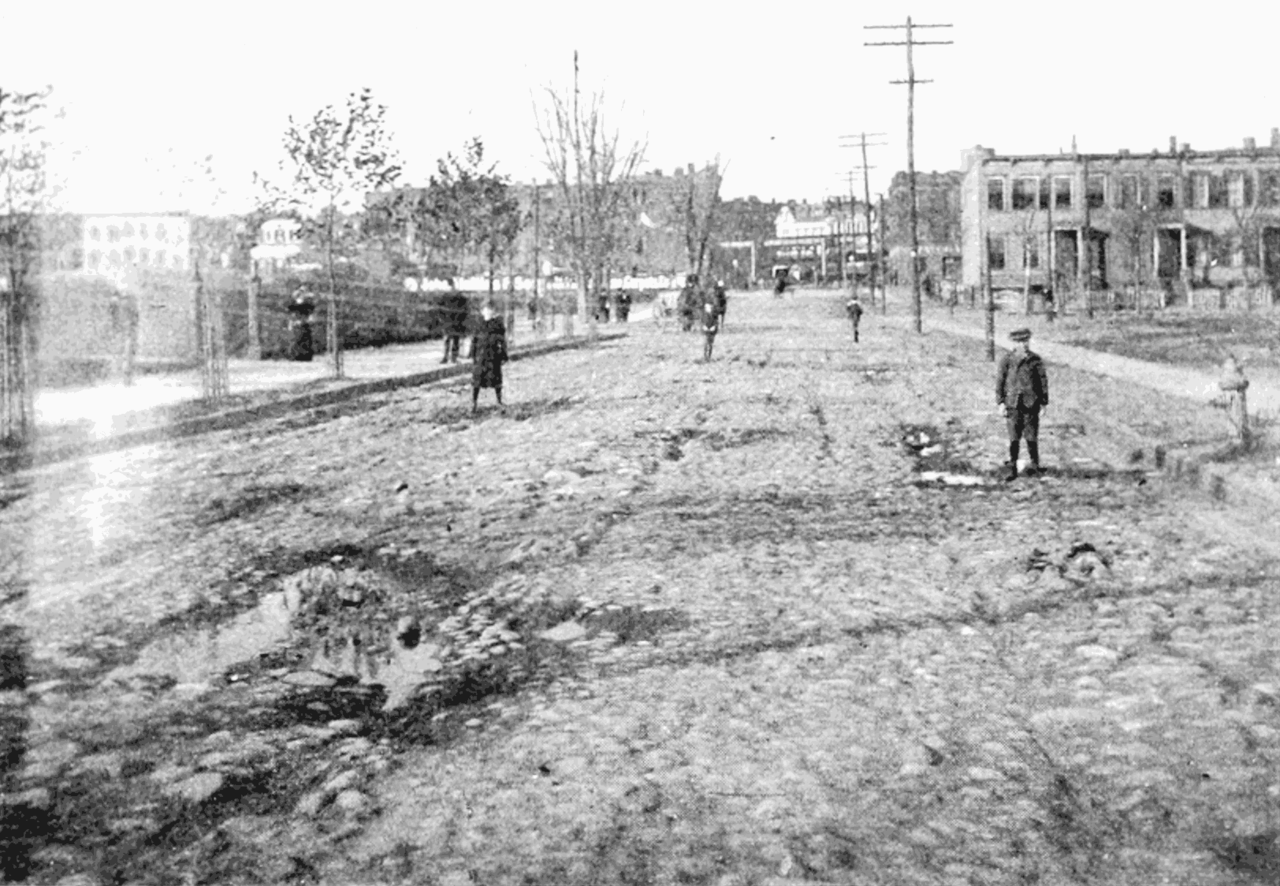
******************************************************************************************************************************** Brownstone Detectives investigates the history of our clients’ homes. The story you are about to read was composed from research conducted in the course of one of those investigations. Do you know the history of YOUR house? ******************************************************************************************************************************** We’d never seen this 1899 picture before – the cobblestones of Saratoga Avenue – taken from Macon Street looking north. To the left you see the gates of the 3-year old Saratoga Square Park and to the right, what was known then as Saratoga Field. A few years before this shot was taken, you would have seen the circus and the various Wild West shows of the time camping out on these two blocks, attracting crowds of people from miles around to the neighborhood. In the distance, you can see the elevated Brooklyn Rapid Transit track, known around this time as the Broadway Elevated, which had opened in 1893 and was a 2-track line at the time. That’s right – no express! And staring back at you are some of the folks who lived and played in the area. It appears from the shot that they were positioned by the photographer. They’re all standing still and upright. Across the street from the park (on the right side of the photograph) would soon be built the Arcadia Dancehall, a “modern dancehall for working girls,” where the modern dances of the day – such as the Bunny Hug and the Tango – were forbidden. Vice President Calvin Coolidge and Teddy Roosevelt’s son, Theodore, […]
THE COP, THE VIRUS, & THE PARROT (1930)
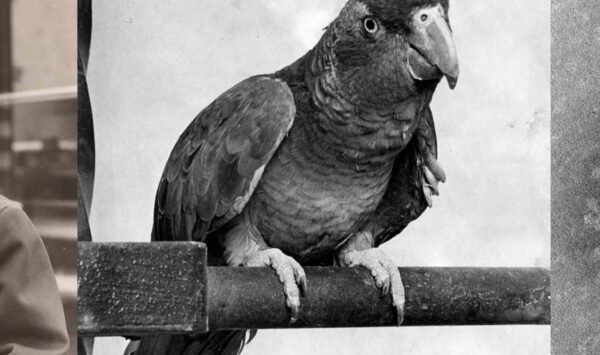
******************************************************************************************************************************** Brownstone Detectives investigates the history of our clients’ homes. The story you are about to read was composed from research conducted in the course of one of those investigations. Do you know the history of YOUR house? ******************************************************************************************************************************** One night in January of 1930, a recent NYPD Academy graduate, Officer Charles Suss, was patrolling his beat at Macon Street and Howard Avenue. “Six nights he has tramped his frosty beat in the cold hours between midnight and 8 a.m.,” the New York Times reported. “Six nights he has tramped his beat aimlessly, hoping for something to happen.” But then, as now, rookie cops got the worst time shifts. Also, Macon and Howard, according to the Times, was “a far removed section of Brooklyn” that was “apparently devoid of crimes. “There was only silence and a little rain.” But at 5 o’clock on that frosty January morning “Suss and his still brightly varnished stick swung down Howard Avenue. “The patrolman, as usual, was brooding on crime,” the Times claimed. “He had just decided that the girl he was rescuing would have light hair and blue eyes. In another moment they would be in the Marriage License Bureau at the Municipal Building.” But then came a “cry from the middle of Saratoga Park.” “Hello, Jake,” it cried. “Help! Help!” “Suss and his club streamed into the thin bushes of the park, guided by the racket and the calls for help. Suss remembered his undergraduate days and what he had been told […]
A JUNGLE MARCHED THRU BED-STUY (1900)
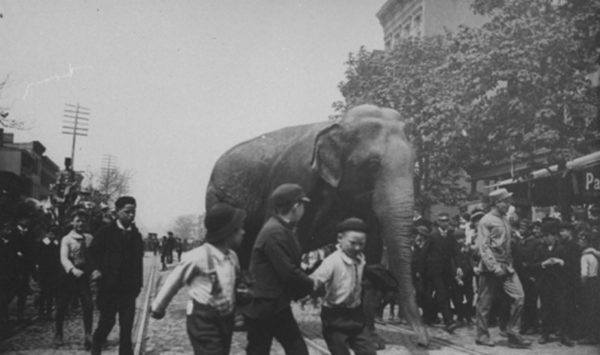
******************************************************************************************************************************** Brownstone Detectives investigates the history of our clients’ homes. The story you are about to read was composed from research conducted in the course of one of those investigations. Do you know the history of YOUR house? ******************************************************************************************************************************** The grey mastodons pounded threateningly down Howard Avenue past the gloomy darkness of Saratoga Square Park. Lumbering slowly around the corner onto Macon Street, they let forth a great trumpeting roar, swaying rhythmically to and fro. As their long, great shadows danced menacingly on the canopy of the park’s trees, cast vaguely by the faint light of the omnipresent red and green flickering colored torches, they presented a terrifying and foreign spectacle. Hundreds of small boys darted in and out of the gathering throngs to view the intimidating beasts, instilling in the air a noticeably heightened excitement which spread further and further down the block, as the presence of these creatures became known. As these majestic monsters moved towards 738 Macon Street, they let out their crushing roar which now could be felt more by the bones than by the ears. A great moan of excited joy leapt, in a synchronized response, from the lips of the visually excited crowd as each and every person lining the Macon Street parade route viewed the very first elephants. As the grey forms, dabbled in red and green light, diminished in size on their trek towards Ralph Avenue, they were replaced by the great humpbacked dromedaries with their inartful steps and studied looks of […]
THE GREAT BROOKLYN FLOOD OF 1903
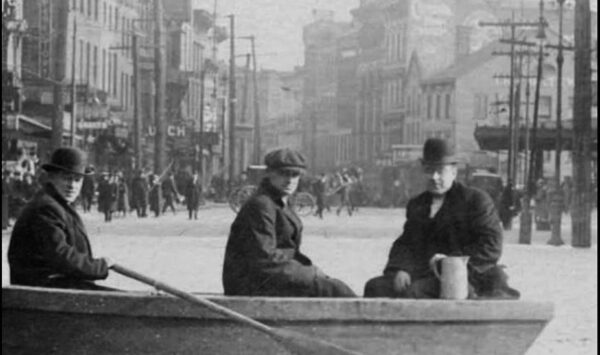
******************************************************************************************************************************** Brownstone Detectives investigates the history of our clients’ homes. The story you are about to read was composed from research conducted in the course of one of those investigations. Do you know the history of YOUR house? ******************************************************************************************************************************** By 7 a.m. on Friday, 9 October 1903, the cellars all along Macon Street were completely inundated with water that was rising quickly toward the basement joists. Without let up, the turgid brown waters continued to pour into the homes through the under-stoop doorways until the floodwaters had reached the level of the basement windowsills, whereupon it then began to pour also through the windows and into the basement dining rooms. The Ocean Hill area, like much of Brooklyn, had fallen victim of the heavy rains that had been falling continuously for much of the night. All the residences along Hancock, McDonough, Macon, Decatur, Bainbridge and Chauncey Streets were so flooded that residents on the ground floor apartments discovered upon waking that they were forced to go to the second floors to escape the waters. “IN SARATOGA PARK…BENCHES WERE FLOATING ABOUT…” The paths in Saratoga Park, according to one newspaper account, “had become running streams and benches were floating about.” The nearby Putnam and Halsey streetcars stopped running, as “it was impossible to take on any passengers, as the water was as high as the seats.” Streets and sidewalks were submerged under several inches of water, and, eventually, furniture moving vans were pressed into service by the police to be used […]
“PEACE” COMES TO STUYVESANT EAST (1921)
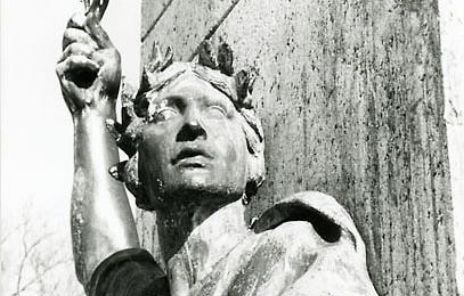
******************************************************************************************************************************** Brownstone Detectives investigates the history of our clients’ homes. The story you are about to read was composed from research conducted in the course of one of those investigations. Do you know the history of YOUR house? ******************************************************************************************************************************** In 2014, The Brownstone Detectives partnered with the New York City Parks Department to help celebrate the lives of the servicemembers of Bedford-Stuyvesant Heights who made the ultimate sacrifice during the Great War. We researched these heroes to locate pictures, stories, and their descendants to be brought together for a ceremony that dedicated a new “Victory and Peace” war memorial at Saratoga Park. ******************************************************************************************************************************** After nearly three years of mourning, Stuyvesant East was ready to remember its dead in a very public way. On 11 September 1921, after neighbors in the eastern section of Stuyvesant Heights had spent two years collecting the $6,000 necessary to defray the cost of a war memorial, the Victory and Peace statue was finally delivered to Saratoga Square. With great pomp and circumstance, amid a good deal of political speech-making and the delivery of grandiose eulogies and war veterans celebrating the war’s end, the 6-ton war memorial, sculpted by James Novelli, was unveiled at the Saratoga Avenue entrance to the Saratoga Square in front of more than 3,000 witnesses. “The eastern end of the park had been appropriately decorated with the monument draped in large American flags which at the presentation were dropped by two servicemembers presenting to view the ten-foot Milford granite memorial.” Revealed was […]
THE HERO OF THE HALSEY STREET FIRE (1911)
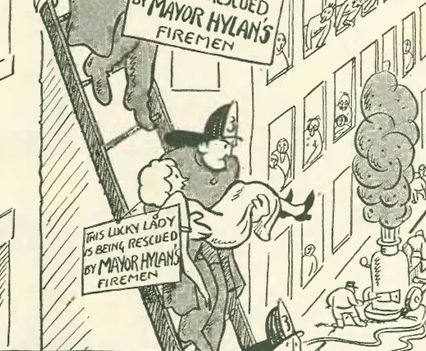
******************************************************************************************************************************** Brownstone Detectives investigates the history of our clients’ homes. The story you are about to read was composed from research conducted in the course of one of those investigations. Do you know the history of YOUR house? ******************************************************************************************************************************** Late in 1911, on a brisk early November morning, a fire broke out in the ground floor store of a 4-story corner apartment building across the street from Saratoga Square Park. It quickly spread, engulfing the entire building. Smoke pouring out of the store on the ground floor of 801 Halsey Street was first seen by a streetcar motorman, William Coffey, who, thinking quickly, began to clang his streetcar gong to arouse the sleeping inhabitants of the building. Coffey and his conductor, along with their six passengers, descended from the car and rushed to the building to do what they could do to assist in evacuating the residents. The fire had apparently started on the ground floor on the Halsey side of the building in a stationery store run by Wolf Bialik. Next door was a grocery store operated by Ernest Seemeyer. The flames then quickly “shot up the dumb waiter shaft to the roof, mushrooming out on each floor.” DETECTIVE O’HARA TO THE RESCUE Across the street, at No. 98 Howard Avenue, a 37-year-old police detective, Irving A. O’Hara, upon hearing the street car gong, had begun dressing quickly and rushed across the street to assist. By this point, the three families living in the building had made it out […]